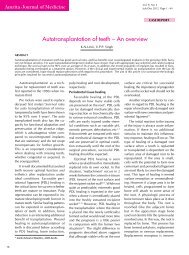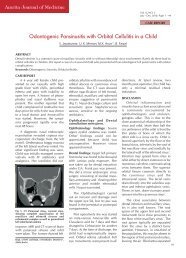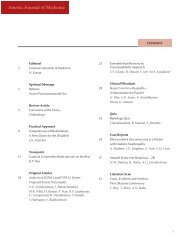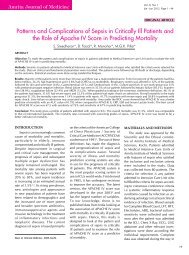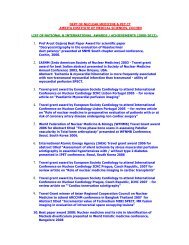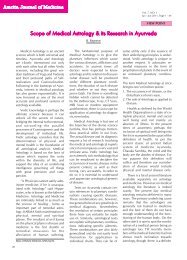Journal of Medicine Vol 2 - Amrita Institute of Medical Sciences and ...
Journal of Medicine Vol 2 - Amrita Institute of Medical Sciences and ...
Journal of Medicine Vol 2 - Amrita Institute of Medical Sciences and ...
Create successful ePaper yourself
Turn your PDF publications into a flip-book with our unique Google optimized e-Paper software.
<strong>Amrita</strong> <strong>Journal</strong> <strong>of</strong> <strong>Medicine</strong><br />
Obesity in Children <strong>and</strong> Adolescents<br />
Table 2: <strong>Medical</strong> Evaluation <strong>of</strong> a Child or an Adolescent Who Is Overweight<br />
Evaluation <strong>of</strong> growth: Normal growth (especially height) makes metabolic or genetic form <strong>of</strong> overweight less likely<br />
Family history <strong>of</strong> premature coronary heart disease, dyslipidemia, diabetes<br />
Diet history, history <strong>of</strong> smoking<br />
History <strong>of</strong> sleep-disordered breathing<br />
Assessment <strong>of</strong> physical activity <strong>and</strong> sedentary behaviour<br />
Psychiatric assessment<br />
History <strong>of</strong> irregular menstrual periods, acne, <strong>and</strong> hirsutism in adolescent girls<br />
(evidence <strong>of</strong> polycystic ovarian syndrome).<br />
Skin disorders like intertrigo, monilial dermatitis, acne <strong>and</strong> acanthosis nigricans.<br />
Blood pressure measurement (multiple readings with attention to proper cuff size)<br />
Physical assessment for orthopedic abnormalities<br />
Urine analysis, fasting lipid pr<strong>of</strong>ile, Serum uric acid, C-Reactive Protein,<br />
Fasting glucose, fasting insulin, HbA1c level<br />
Liver function tests, thyroid function tests<br />
Renal function tests (if hypertension is present)<br />
Abdominal USG (for fatty liver, ovarian cysts)<br />
PREVENTION OF OBESITY<br />
The ideal preventive strategy for obesity is to prevent<br />
children with a normal, desirable BMI from becoming<br />
overweight or obese. Preventive strategies should start as<br />
early as newborn period. Both initiation <strong>and</strong> duration <strong>of</strong><br />
breast-feeding may reduce the risk <strong>of</strong> later overweight 52 .<br />
A reasonable goal for preschool interventions would be<br />
to aim toward weight gain <strong>of</strong> 1.0 kg/2 cm <strong>of</strong> growth.<br />
This rate <strong>of</strong> gain from preschool age (3 to 4 years) onward<br />
predicted desirable weight at 8 to 9 years <strong>of</strong> age,<br />
whereas a gain <strong>of</strong> 1.8 kg/2 cm predicted obesity at elementary<br />
school age 53 . The important role <strong>of</strong> healthful<br />
behaviors has increasingly been documented. Behavior<br />
modifications should focus on increasing consumption<br />
<strong>of</strong> fruits, vegetables <strong>and</strong> fiber-containing grain products,<br />
avoidance <strong>of</strong> high calorie/high fat food items, increasing<br />
daily physical activity, <strong>and</strong> limiting sedentary time.<br />
Interventions that include classroom <strong>and</strong> physical<br />
education sessions, changes in school meals, vending<br />
machines, <strong>and</strong> cafeterias, <strong>and</strong> after-school programs, can<br />
increase physical activity <strong>and</strong> improve dietary patterns in<br />
children <strong>and</strong> adolescents 54,55 . One recent study has emphasized<br />
reducing television, videotape/DVD, <strong>and</strong> video<br />
game use 32 . There are also successful examples <strong>of</strong> physical<br />
education interventions designed with higher-intensity<br />
or more motivating activities, specifically endurance training<br />
56 <strong>and</strong> popular dance 57 . Exposure to various media is<br />
critical. A substantial proportion <strong>of</strong> the advertising on<br />
children’s television promotes food, <strong>and</strong> there is a direct<br />
relationship between television viewing <strong>and</strong> obesity 58 .<br />
Reducing television viewing has reduced weight gain <strong>and</strong><br />
the prevalence <strong>of</strong> obesity in experimental trials 32,59 . It has<br />
been hypothesized that television promotes obesity<br />
through the consumption <strong>of</strong> food while watching television,<br />
the consumption <strong>of</strong> foods advertised on television,<br />
or reduced physical activity 58,60,61 .<br />
TREATMENT OF OBESITY<br />
In treating children with overweight <strong>and</strong> obesity, the<br />
immediate goal is to bring down the rate <strong>of</strong> weight gain,<br />
followed by a period <strong>of</strong> weight maintenance <strong>and</strong> finally<br />
weight reduction to improve BMI. Children 2 to 4 years<br />
old who are overweight or obese will achieve reductions<br />
in BMI percentile by achieving a rate <strong>of</strong> weight gain < 1<br />
kg/2 cm <strong>of</strong> height gain. Older Children who are obese<br />
without comorbidities may achieve BMI percentile reductions<br />
to below overweight cut-<strong>of</strong>fs with BMI<br />
maintenance. Children who are obese with comorbidities<br />
require an aggressive approach to bring in weight loss in<br />
concurrence with other treatment strategies. A gradual<br />
weight loss is preferred because it is achievable <strong>and</strong> more<br />
easily sustained giving long-term benefits. Older adolescents<br />
who have completed linear growth <strong>and</strong> have a BMI<br />
>30 kg/m 2 require more aggressive weight loss similar<br />
to that for adults 62 . The principles for the treatment <strong>of</strong><br />
obesity can be summarized as follows:<br />
1. Establish individual treatment goals <strong>and</strong> approaches<br />
on a case-to-case basis.<br />
2. Ensure family involvement through out the treatment<br />
period.<br />
8



